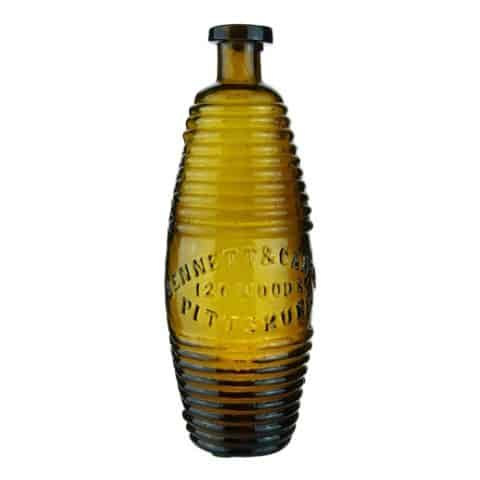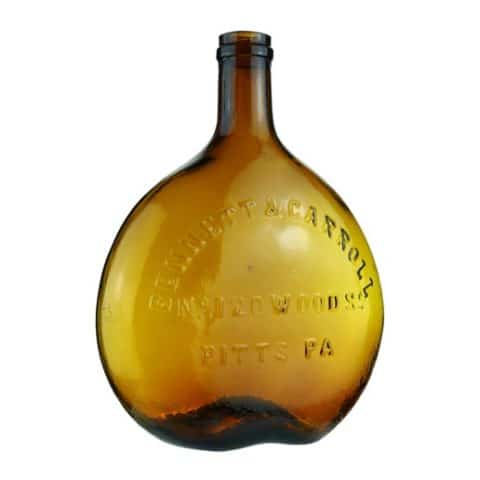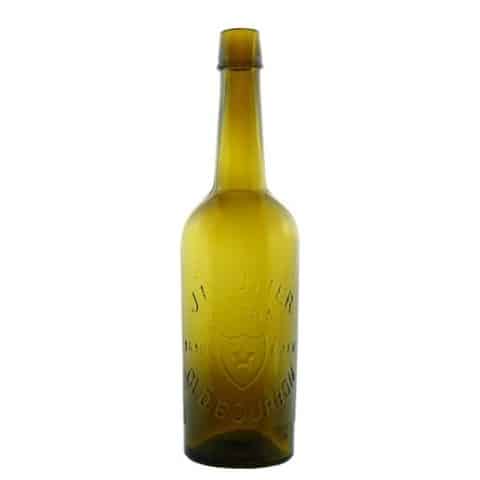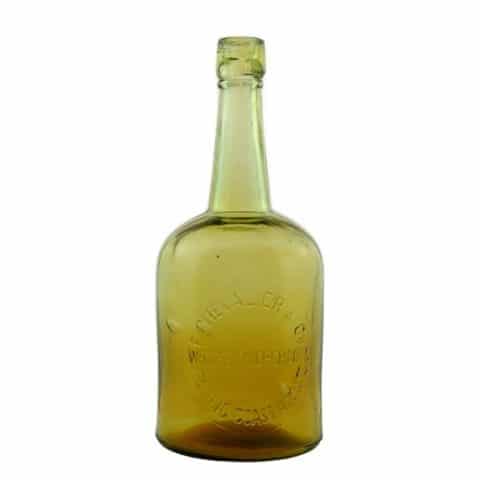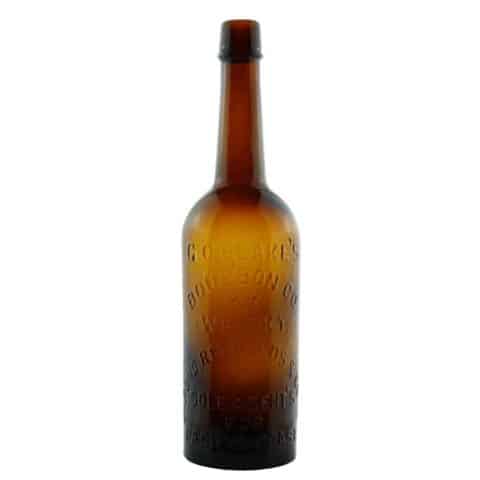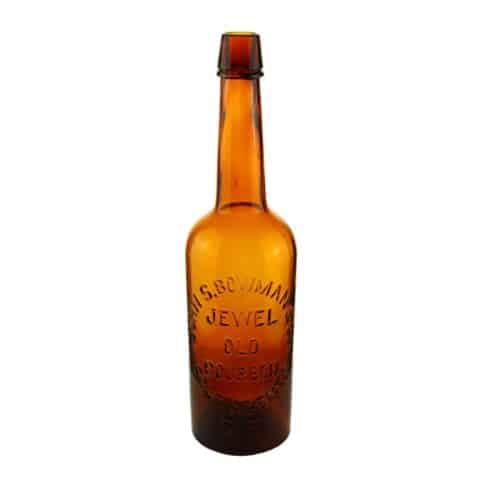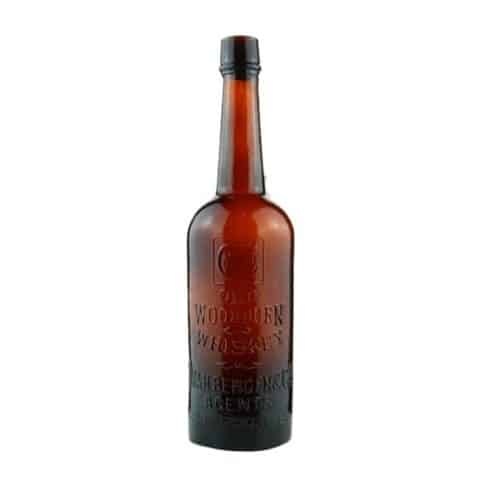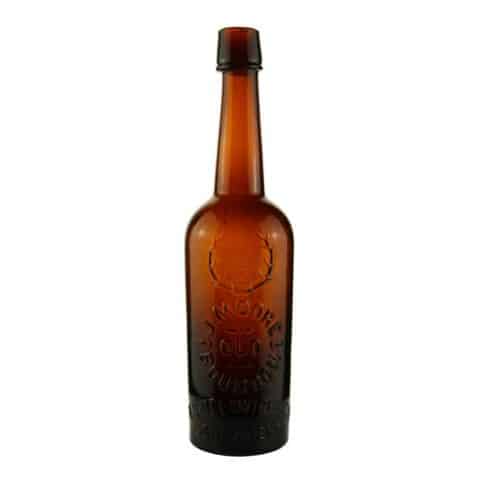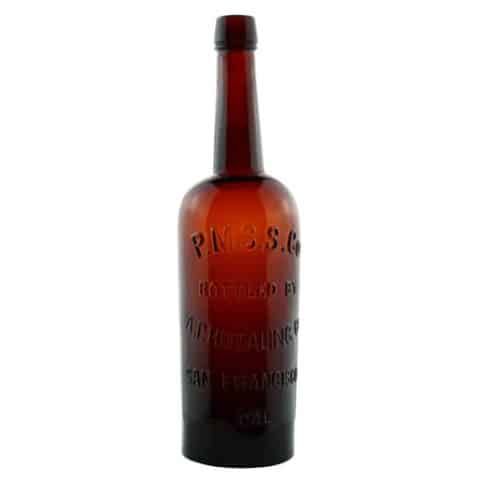Lilienthal & Co. S.F.
Lilienthal & Co. S.F.
(Union Oval Flask)
Blue Lick Kentucky Whiskey
Light Olive Green
Provenance: Steven Hubbell Collection

Our museum bottle embossed ‘LILIENTHAL & CO. S.F.’ is one of the oldest western flasks as it was made and sold from 1872 to about 1880. The flask form is referred to as a “Union Oval.”
There are two variants of this flask. One has a high embossed ‘S.F.’ while the other, ‘S.F.’ occurs lower on the face of the flask. Our example would be the high variant. This example is extraordinary in its condition and olive glass color as most examples are found in shades of amber.

Lilienthal & Co. had their name embossed on quite a few flasks and these bottles are cherished by collectors. We have pictured a number of the flasks above in the scrolling images. Besides our subject LILIENTHAL & CO. S.F. union oval flask, there is a large and small pattern cylinder fifth embossed ‘LILIENTHAL & CO. SAN FRANCISCO’ with the crown and L&Co. monogram shield.
Most of the Lilienthal ‘union oval’ flasks seem to have been found in old mining towns in Nevada such as Hamilton, Treasure City, Aurora, Darwin, Austin, Virginia City, and Cornucopia according to John L. Thomas. An example is referenced in his book that has a tough-to-read partial label reading ‘Blue Lick’ which was a Kentucky whiskey.
There is also a Lilienthal “3-city’ flask that is embossed with two outline circles, ‘LILIENTHAL & CO. DISTILLERS, CINCINNATI, SAN FRANCISCO & N.Y.’ It is considered the rarest of the Lilienthal flasks and is attributed to Albert Lilienthal.
There is a banded embossed ‘LILIENTHAL & CO. S.F.’ “cognac style” flask that usually occurs with a double roll lip. There is also a ‘banded distillers” flask that is plain amber and has a double roll color. Most examples have a tooled top. The embossed copy is set within a rounded oblong oval outline that has two vertical oval outlines within. The embossed copy reads, ‘LILIENTHAL & CO. DISTILLERS.’ There are two embossed stars and the crown and L&Co. monogram shield.
Another bottle is a clear “pumpkin-seed” flask embossed ‘LILIENTHAL & CO. DISTILLERS’ with the crown and L&Co. monogram shield. Another bottle variant is the Lilienthal ‘teardrop’ flask. There are a number of similar variants. They all have the crown and L&Co. monogram shield and a screw cap.
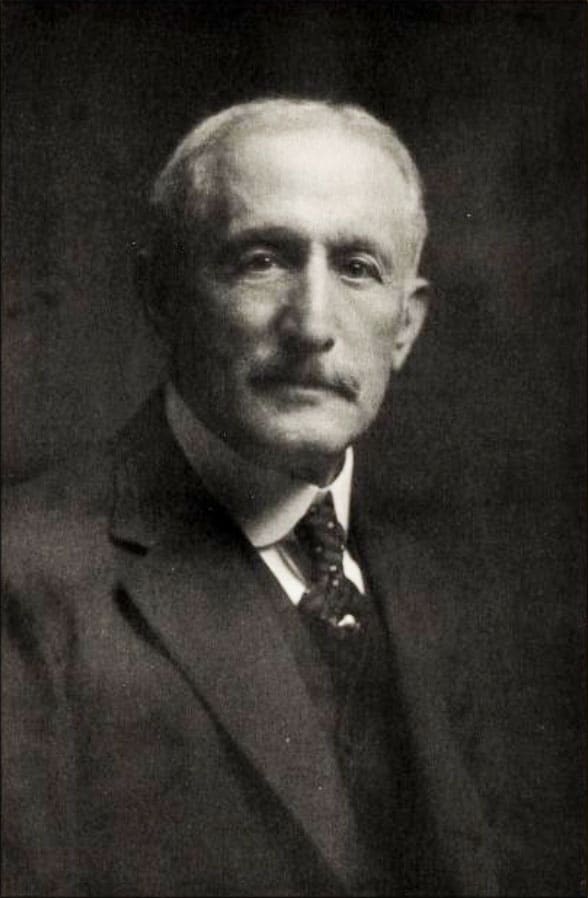
The Lilienthal brand and business was established by Ernest Reuben Lilienthal, who was born in Lockport, New York on August 30, 1850. In 1866, his senior year in high school, Ernest worked part-time at the Seligman bank in New York. After graduation, he continued to work for the bank until 1867 when he moved to Cincinnati to study law. He obtained a Bachelor of Law degree from the Cincinnati Law School and was admitted to the bar but never practiced professionally.
Lilienthal aspired to move into the mercantile field and a business opportunity was arranged for him when he was connected with Julius Freiberg, by an esteemed family member, Rabbi Max Lilienthal. Julius was the head of Freiberg and Workum, wholesale liquor dealers, rectifiers, and distillers of whiskey in Kentucky and Ohio. Freiberg was persuaded to employ Ernest, who first worked in the blending department and then was sent as a salesman to New York City. He did well and an arrangement was made for Ernest to move to San Francisco with credit from Freiberg and Workum to take their products into the San Francisco market. This was the beginning of Lilienthal and Company.
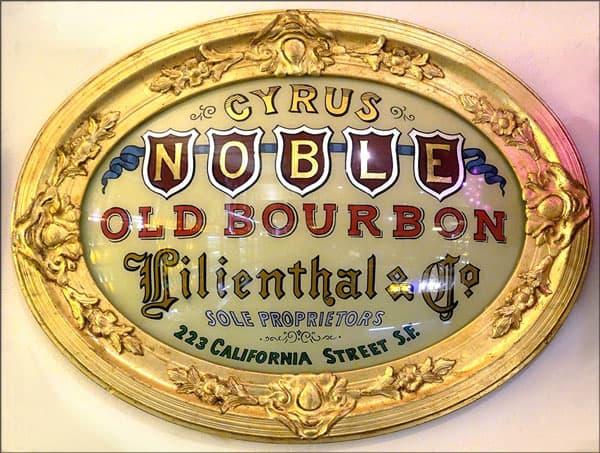
On his arrival in San Francisco in the summer of 1871, Ernest immediately rented store space at 223 California Street and displayed the sign of Lilienthal and Company. In the beginning, he bought only from Freiberg and Workum of Cincinnati, operating as a wholesaler on their merchandise but in business for himself. The principal brands in their stock were “Cyrus Noble,” named for the superintendent of the Freiberg and Workum Distillery at Lynchburg, Ohio, and W. A. Lacey Whiskey.
Lilienthal soon married Hannah Isabelle “Bella” Sloss on May 10 1876 in San Francisco, California. She was the daughter of a wealthy merchant. Their first residence was a house addressed at 1818 California Street.

Under their own formulae, many other brands were blended and sold by Lilienthal & Co. The many bottles and flasks noted above were labeled and carried the Lilienthal stamp. Their whiskey was brought out in barrels, frequently by sailing ship around Cape Horn to speed the aging through continued agitation in the hold of the ship, and on arrival were either sold by the barrel or bottled and sold by the case.
As the firm expanded, it naturally took on more employees, one of whom was Hugo Arnhold. Arnhold functioned as a traveling representative of the firm throughout California and Nevada. One of his more spectacular sales was in Eureka.
Eureka, a wide-open mining town in Nevada, had been completely gutted by fire. All the liquor of the town had gone up in smoke, as well as the houses and stores, and Arnhold was given an order for whiskey and the like, which took almost all of the company’s stock. In San Francisco, a debate ensued as to the wisdom of shipping almost the entire stock to one place, but Ernest decided that the order should be filled. There was always more to be had, and a sale was a sale. This is why so many Lilienthal flasks have been found in Nevada mining towns.
Ernest soon sent for his brother, John Leo. Leo was a quiet, methodical young man. He became invaluable to Ernest, relieving him of the details of the inside office and warehouse. Leo took charge of blending and bottling operations and tended to inventories, incoming shipments, invoices and deliveries, and accounting.
Albert Lilienthal next joined the family group in San Francisco. He came with the intention of developing the hop and grain business of the company. Though he was successful, he did not like California, so he returned to New York, where he and Theodore formed Lilienthal Brothers, which firm, among other activities, acted as the Eastern representatives of Lilienthal and Company in San Francisco. The “3-cities” LILIENTHAL & CO. DISTILLERS flask can be attributed to Albert as noted previously.
Ernest Reuben Lilienthal died in 1922. You can still find the Cyrus Noble name on labels today though the Lilienthal relationship has been long removed.
Primary Image: The Lilienthal & Co. flask imaged on location by the FOHBC Virtual Museum midwest studio led by Alan DeMaison.
Support: Whiskey Bottles of the Old West by John L. Thomas, 2002
Support: Ernest Reuben Lilienthal and his family by Frederic Gordon O’Neill, 1949
Support Images: Jeff Wichmann and American Bottle Auctions, and the archives of FOHBC Bottles and Extras.
Join the FOHBC: The Virtual Museum is a project of the Federation of Historical Bottle Collectors (FOHBC). To become a member.









